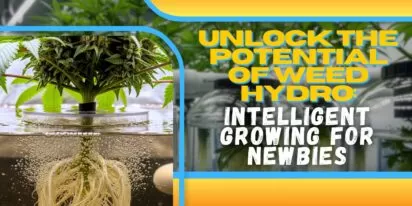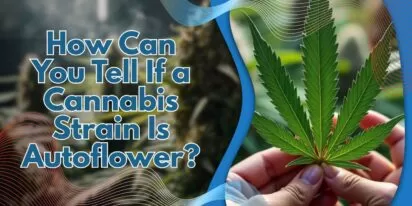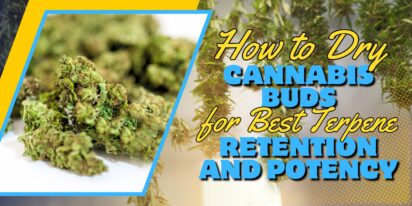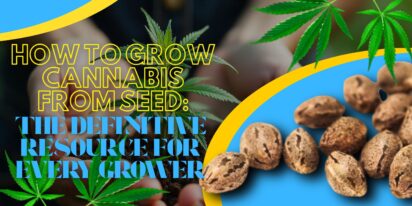Table of Contents

In the ever-expanding world of cannabis cultivation, the significance of identifying high quality marijuana seeds cannot be overstated. Whether you are a seasoned grower or a novice enthusiast, the foundation of a successful cannabis garden lies in selecting top-notch seeds. High-quality seeds ensure robust plant growth and contribute to developing desirable traits, potency, and overall yield. Investing in superior genetics prepares you for a rewarding and fruitful cannabis cultivation journey.
This blog aims to equip you with a comprehensive guide that will enable you to identify high-quality marijuana seeds confidently. We understand that navigating the vast array of seed options can be overwhelming, and it can be challenging to differentiate between bad seeds and those that have the potential to flourish into exceptional cannabis plants. Through this guide, we aim to shed light on the key factors that influence seed quality, educate you on effective methods of seed identification, and offer valuable insights on where to source reliable seeds. By the end of this blog, you will possess the knowledge and tools necessary to make informed decisions when selecting marijuana seeds, setting you on the path to a successful cultivation experience. So, let’s delve into the world of high-quality marijuana seeds and unlock the secrets to growing exceptional cannabis plants.
Before we dive into identifying high quality marijuana seeds, it’s essential to have a basic understanding of what marijuana seeds are. Marijuana seeds, also known as cannabis seeds, are the reproductive units of the cannabis plant. They contain the genetic information needed to develop into a mature cannabis plant with specific traits, including aroma, flavor, potency, and growth characteristics. Each seed holds the potential to become a unique cannabis cultivar with its own set of characteristics.
When exploring the world of marijuana seeds, you will come across different types, each offering distinct advantages. Understanding these types will assist you in choosing the most suitable seeds for your cultivation goals.
Regular seeds: Regular seeds are traditional, non-genetically modified seeds. They have a 50/50 chance of producing male or female plants. Regular seeds are popular among breeders who want to create new strains by crossing male and female plants.
Feminized seeds: Feminized seeds are selectively bred to produce only female plants, eliminating the need to identify and remove male plants that do not produce buds. Feminized seeds offer a higher likelihood of obtaining a crop with potent flowers and are favored by growers seeking to maximize yield.
Autoflowering seeds: Autoflowering seeds are convenient for novice and experienced growers. These seeds are genetically engineered to transition from the vegetative stage to the flowering stage automatically, based on their age rather than changes in light cycles. Autoflowering seeds typically have a shorter growth cycle and can be cultivated year-round.
To effectively identify high-quality marijuana seeds, it’s helpful to understand the anatomy of a seed. A typical marijuana seed consists of three main parts:
Seed shell: The outer protective covering of the seed is called the shell or seed coat. It can vary in color, texture, and thickness. A healthy seed shell should be intact and free from cracks or damage.
Embryo: The embryo is the vital part of the seed that contains the genetic material necessary for growth and development. It consists of the embryonic shoot (stem) and the embryonic root. The embryo is usually pale or light green.
Cotyledons: Cotyledons, also known as seed leaves, are the first structures to emerge from the seed upon germination. They provide the initial nutrients to the young seedling until it develops true leaves and starts photosynthesis. Cotyledons are typically rounded and fleshy, ranging from pale green to yellowish.
Understanding the anatomy of a marijuana seed will aid you in assessing its overall health and potential for successful germination and growth. Examining the seed shell, embryo, and cotyledons allows you to gather valuable insights into the seed’s viability and overall quality.
When it comes to identifying high quality marijuana seeds, several factors come into play. Understanding these factors will empower you to make informed decisions and select seeds with the greatest potential for success. Let’s explore the key factors that influence seed quality.
Genetics plays a crucial role in determining the quality of marijuana seeds. Different cannabis strains possess unique genetic characteristics contributing to their growth patterns, cannabinoid profiles, flavors, and aromas. Opting for reputable breeders and well-established seed banks ensures that you work with reliable genetics and increases the likelihood of obtaining high-quality seeds.
Seed maturity is a vital factor that impacts seed quality. Seeds that have reached full maturity have a higher chance of germination and successful growth. Immature seeds are more likely to be non-viable or produce weak, underdeveloped seedlings. It is essential to source seeds from reputable suppliers who prioritize seed maturity and employ proper harvesting techniques.
Visual inspection of seeds can provide valuable insights into their quality. While appearance alone is not a definitive indicator, it can reveal a seed’s viability. Look for seeds that exhibit the following characteristics:
Color: Mature cannabis seeds typically showcase darker brown, black, or gray hues. Avoid seeds that appear green or light in color, as they are likely immature or have a lower chance of germination.
Size: Although size can vary, larger seeds often indicate a higher level of maturity and potential vigor. However, remember that size alone is not a foolproof measure of quality, as small seeds can still yield robust plants.
Texture: High-quality seeds generally have a smooth and firm outer shell. Avoid seeds with a cracked, damaged, or excessively brittle shell, as they may have reduced viability.
The age and storage conditions of marijuana seeds can significantly impact their quality and viability. Freshly harvested seeds generally have higher germination rates compared to older seeds. However, with proper storage conditions, seeds can remain viable for extended periods.
Seed age: Seeds gradually lose viability over time, and their germination rates decline. It is advisable to use seeds within one to three years of harvest for optimal results.
Storage conditions: Proper storage is crucial for maintaining seed quality. Store seeds in a cool, dark, and dry environment to minimize exposure to light, heat, and moisture. Airtight containers and desiccant packs can help protect seeds from moisture and prolong their viability.
By considering the genetics, maturity, appearance, and storage conditions of marijuana seeds, you can enhance your chances of selecting high-quality seeds that have the potential to thrive.
Ensuring you select high-quality marijuana seeds is crucial for a successful cultivation experience. While it may seem challenging initially, effective methods exist to identify seeds with the greatest potential for germination and growth. Let’s explore some key techniques for identifying high quality marijuana seeds.
Seed color and patterns: Mature cannabis seeds typically exhibit darker colors like brown, black, or gray. Look for seeds with consistent coloring and avoid seeds that appear green or light in color, as they are likely immature or of lower quality. Some strains may have unique patterns or markings on the seed surface, indicating genetic traits.
Size and shape consistency: High-quality seeds often have a uniform size and shape within a batch. While size alone is not a definitive indicator of quality, seeds that are too small or irregular in shape may have lower viability.
Seed shell integrity: Carefully examine the seed shell for cracks, dents, or other damage. A healthy seed should have an intact and undamaged shell, as a damaged shell can affect germination and overall seed quality.
Firmness and hardness: Gently squeeze the seed between your fingers to assess its firmness and hardness. High-quality seeds are typically firm and resistant to pressure. Seeds that feel soft or crumble easily may indicate poor viability.
Texture and smoothness: Run your fingers over the seed’s surface to check for any irregularities or rough textures. High-quality seeds tend to have a smooth and even texture.
Procedure and purpose: The float test is a simple method to determine seed viability. Fill a glass of water and carefully place the seeds in it. Observe whether the seeds float or sink. The purpose of this test is to identify viable seeds that have a higher chance of germination.
Interpreting the results: Viable seeds generally sink to the bottom of the glass, while non-viable or low-quality seeds tend to float or remain suspended in the water. Remember that the float test is not foolproof, but it can provide a rough indication of seed viability.
1. Steps to conduct a germination test: A germination test involves attempting to germinate a few seeds before committing to a larger batch. Here’s a simple method to conduct a germination test:
a. Moisten a paper towel or cotton pad with water, ensuring it is damp but not soaking wet.
b. Place a few seeds on the moistened paper towel.
c. Fold the paper towel over the seeds to cover them.
d. Keep the paper towel in a warm, dark place, such as inside a sealed plastic bag.
e. Check the seeds regularly for germination, usually within a few days to a week.
2. Evaluating germination rate: Once the germination period is over, count the number of successfully sprouted seeds. A higher germination rate indicates better seed quality.
By employing visual inspection, touch and feel evaluation, conducting a float test, and performing a germination test, you can gather valuable information about the quality and viability of marijuana seeds. When used together, these methods offer a comprehensive approach to identifying high-quality seeds more likely to yield healthy and productive cannabis plants.
Now that you understand identified high-quality marijuana seeds, the next step is to explore the different avenues for obtaining these seeds. Here are some reliable sources where you can find high-quality marijuana seeds:
Seed banks are specialized establishments that store and distribute cannabis seeds from various breeders. Reputable seed banks such as Rocket Seeds are known for their quality control measures and extensive selection of seeds. They work closely with breeders to ensure their seed offerings’ authenticity and genetic integrity. Research and choose seed banks with positive reviews established reputations, and a diverse catalog of strains.
The internet has revolutionized the way we access and purchase cannabis seeds. Online marketplaces offer a convenient platform for browsing and ordering seeds from various breeders and seed banks. Look for reputable online platforms prioritizing customer satisfaction, providing detailed strain information, and having secure payment and discreet shipping options.
Cannabis expos and events bring together growers, breeders, and enthusiasts from the industry. These gatherings offer a unique opportunity to connect directly with breeders, learn about the latest advancements in genetics, and acquire high-quality seeds. Attend local cannabis expos, trade shows, and festivals to meet reputable breeders, gain insights, and potentially acquire exclusive and rare seed varieties.
Check if your local dispensaries or cultivation supply stores carry a selection of marijuana seeds. These establishments often collaborate with trusted breeders and seed banks to provide customers with reliable and high-quality seeds. Additionally, connecting with local growers or joining cannabis cultivation communities can provide opportunities to source seeds from experienced individuals with firsthand knowledge of specific strains and genetics.
When obtaining marijuana seeds, prioritize reputable sources that prioritize quality control, offer reliable genetics, and have a track record of customer satisfaction. Remember, it’s worth investing in high-quality seeds as they form the foundation for a successful and rewarding cannabis cultivation experience.

Curious about growing weed in a healthy, effective way? Welcome to the realm of weed hydro! This method uses water instead of soil, delivering n

Peyote Zkittlez is a unique cannabis strain that has quickly gained dedicated followers among enthusiasts and patients alike. Its parentage—Zk

As growers, we want strains that work well, are strong, and are of good quality. Autoflowering cannabis strains are a big step forward for both

Pot growers always ask the same basic question: How much weed does a weed plant produce? The answer is complex and depends on a multitude of var

Ever had the room spin after a few hits? You're not alone. Figuring out how to prevent getting dizzy high can make your cannabis experience a wh

Drying cannabis properly is a critical process in preserving the plant's full aroma and flavor and its psychoactive abilities. Tampering with th

Ever caught yourself a bit too high and all of a sudden in need of being normal? Whether you're heading out for munchies or bumping into someone

Looking for sage advice on how not to get pinched with weed without batting an eye? Attempting to protect your stash from gossipy roommates, sno

Nutrient lockout, also known as nutrient binding or chemical antagonism, is a significant issue in cannabis cultivation that negatively impacts

Germination is the most critical initial stage in growing healthy, high-quality cannabis plants. During germination, the dormant seed becomes a
Are You 18 Or Over?
By selecting “Continue”, you confirm that you are at least 18 years of age and legally permitted to access cannabis related content in your region.
By using Rocketseeds.com, you agree to our legal disclaimer.
Excellent blog here Also your website loads up very fast What web host are you using Can I get your affiliate link to your host I wish my web site loaded up as quickly as yours lol
Your writing is not only informative but also incredibly inspiring. You have a knack for sparking curiosity and encouraging critical thinking. Thank you for being such a positive influence!
Simply wish to say your article is as amazing The clearness in your post is just nice and i could assume youre an expert on this subject Well with your permission let me to grab your feed to keep updated with forthcoming post Thanks a million and please carry on the gratifying work
Somebody essentially lend a hand to make significantly articles Id state That is the very first time I frequented your website page and up to now I surprised with the research you made to make this actual submit amazing Wonderful task
Your blog is a beacon of light in the often murky waters of online content. Your thoughtful analysis and insightful commentary never fail to leave a lasting impression. Keep up the amazing work!
Thank you for the auspicious writeup It in fact was a amusement account it Look advanced to more added agreeable from you By the way how could we communicate
Your blog is a constant source of inspiration for me. Your passion for your subject matter shines through in every post, and it’s clear that you genuinely care about making a positive impact on your readers.
Your blog is a constant source of inspiration for me. Your passion for your subject matter is palpable, and it’s clear that you pour your heart and soul into every post. Keep up the incredible work!
Your articles never fail to captivate me. Each one is a testament to your expertise and dedication to your craft. Thank you for sharing your wisdom with the world.
Your blog is a testament to your dedication to your craft. Your commitment to excellence is evident in every aspect of your writing. Thank you for being such a positive influence in the online community.
Your writing has a way of resonating with me on a deep level. I appreciate the honesty and authenticity you bring to every post. Thank you for sharing your journey with us.
Your blog is a true gem in the world of online content. I’m continually impressed by the depth of your research and the clarity of your writing. Thank you for sharing your wisdom with us.
Hi i think that i saw you visited my web site thus i came to Return the favore Im attempting to find things to enhance my siteI suppose its ok to use a few of your ideas
Somebody essentially help to make significantly articles Id state This is the first time I frequented your web page and up to now I surprised with the research you made to make this actual post incredible Fantastic job
Usually I do not read article on blogs however I would like to say that this writeup very compelled me to take a look at and do so Your writing taste has been amazed me Thanks quite nice post
Your blog has quickly become one of my favorites. Your writing is both insightful and thought-provoking, and I always come away from your posts feeling inspired. Keep up the phenomenal work!
Every time I visit your website, I’m greeted with thought-provoking content and impeccable writing. You truly have a gift for articulating complex ideas in a clear and engaging manner.
Hey there You have done a fantastic job I will certainly digg it and personally recommend to my friends Im confident theyll be benefited from this site
I have read some excellent stuff here Definitely value bookmarking for revisiting I wonder how much effort you put to make the sort of excellent informative website
Nice blog here Also your site loads up very fast What host are you using Can I get your affiliate link to your host I wish my site loaded up as quickly as yours lol
What i do not understood is in truth how you are not actually a lot more smartlyliked than you may be now You are very intelligent You realize therefore significantly in the case of this topic produced me individually imagine it from numerous numerous angles Its like men and women dont seem to be fascinated until it is one thing to do with Woman gaga Your own stuffs nice All the time care for it up
Your blog is a beacon of light in the often murky waters of online content. Your thoughtful analysis and insightful commentary never fail to leave a lasting impression. Keep up the amazing work!
Your blog is a breath of fresh air in the often stagnant world of online content. Your thoughtful analysis and insightful commentary never fail to leave a lasting impression. Thank you for sharing your wisdom with us.
Your blog is a beacon of light in the often murky waters of online content. Your thoughtful analysis and insightful commentary never fail to leave a lasting impression. Keep up the amazing work!
Usually I do not read article on blogs however I would like to say that this writeup very compelled me to take a look at and do it Your writing style has been amazed me Thank you very nice article
Your writing has a way of resonating with me on a deep level. I appreciate the honesty and authenticity you bring to every post. Thank you for sharing your journey with us.
This hydroponics guide is quite the buzz, seriously! Who knew growing weed without dirt could be so complicated yet potentially rewarding? The breakdown of systems like DWC and NFT is helpful, though I suspect my cat might confuse the air pump for a toy. The idea of cleaner buds is tempting, especially since explaining hydro weed to my non-growing friends might get messy. And the bit about potential dizziness from hydro weed? Perfect, now I have an excuse for why I always stumble a bit after a grow session. Still, the promise of faster grows and higher yields is hard to ignore, even if it means more trips to the pH meter than to the coffee shop. Overall, a cultivating read for the curious grower!